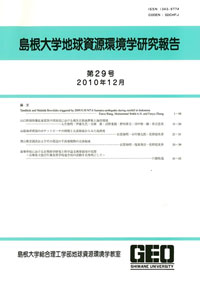島根大学総合理工学部地球資源環境学教室
ISSN:1343-9774

ダウンロード数 : ? 件
この文献の参照には次のURLをご利用ください : https://ir.lib.shimane-u.ac.jp/3247
島根大学地球資源環境学研究報告 18
1999-12-25 発行
琵琶湖北東部,後期白亜紀貝月山花崗岩体
Late Cretaceous Kaizukiyama granite,northeast of LakeBiwa,Southwest Japan
杉井 完治
澤田 順弘
ファイル
内容記述(抄録等)
The Kaizukiyama granite is distributed northeast of Lake Biwa and was intruded into the Jurassic accretionary complex of the Mino-Tamba Belt.The grantic mass crops out over an area of approximately 120k㎡,(14 km N-S,11.5 km E-W).lt consists mainly of equigranular coarse-grained hornblende bearing biotite granite to granodiorite,associated with porphyritic hornblende bearing biotite granite-granodiorite,medium-grained muscovite granite,and granite porphyry.
Equigranular hornblende bearing biotite granite-granodiorite of the Kaizukiyama granite consists mainly Plagioclase,K-feldspar and quartz,with subordinate biotite and hornblende,and accessory opaque minerals,apatite,zircon,monazite,allanite and tourmaline.Porphyritic hornblende bearing biotite granite-granodiotite have the same mineralogy,but contain K-feldspar megacrysts up to 7 cm in length.Medium-grained muscovite granite occurs in the central part of the Kaizukiyama granite as schlieren less than a few tens of meters in width,and consists mainly of plagioclase,K-feldspar,quartz and muscovite,with accessory biotite,garnet,opaque minerals,apatite,zircon and monazite.
Color index(modal composition of mafic minerals)and modal plagioclase / K-feldspar ratio of slab samples and magnetic susceptibility tend to decrease from the margin to core,and with increasing of altitude(from 250 m to 1200 m).
SiO_2 contents of hornblende bearing biotite granite−granodiorite and muscovitegranite from the Kaizukiyama granite are 66.52-72.23 wt% and 75.25-75.87 wt%,respectively.Muscovite granite plots with in the S-type granite field on the ACF diagram of White and Chappell(1977).
Equigranular hornblende bearing biotite granite-granodiorite of the Kaizukiyama granite consists mainly Plagioclase,K-feldspar and quartz,with subordinate biotite and hornblende,and accessory opaque minerals,apatite,zircon,monazite,allanite and tourmaline.Porphyritic hornblende bearing biotite granite-granodiotite have the same mineralogy,but contain K-feldspar megacrysts up to 7 cm in length.Medium-grained muscovite granite occurs in the central part of the Kaizukiyama granite as schlieren less than a few tens of meters in width,and consists mainly of plagioclase,K-feldspar,quartz and muscovite,with accessory biotite,garnet,opaque minerals,apatite,zircon and monazite.
Color index(modal composition of mafic minerals)and modal plagioclase / K-feldspar ratio of slab samples and magnetic susceptibility tend to decrease from the margin to core,and with increasing of altitude(from 250 m to 1200 m).
SiO_2 contents of hornblende bearing biotite granite−granodiorite and muscovitegranite from the Kaizukiyama granite are 66.52-72.23 wt% and 75.25-75.87 wt%,respectively.Muscovite granite plots with in the S-type granite field on the ACF diagram of White and Chappell(1977).
Other Article
PP. 41 - 54
